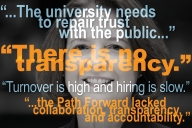You have /5 articles left.
Sign up for a free account or log in.
.jpg?itok=F4w_WMO4)
Higher education institutions are struggling to hire IT talent—but some universities are finding creative workarounds.
Getty Images
Campus technology leaders are applying innovation to their own hiring practices as they struggle to compete for talent with tech companies that prioritize high salaries, work-life balance and flexible in-office days.
IT hiring was a key issue in Chicago this week at the annual Educause conference. The event, which brings together CIOs from across the nation to discuss the intersection of technology and education, includes an annual report of the top 10 trends and challenges facing campus CIOs.
The report ranked hiring at No. 7. “Financial constraints and traditional workplace rigidity are making it hard for technology and data managers to recruit, hire, and retain staff,” according to the report, which will be released publicly Oct. 16.
Similarly, in Inside Higher Ed’s 2023 Survey of Campus Chief Technology/Information Officers, hiring IT professionals came in as a top concern. When it comes to hiring new employees, 36 percent of the respondents said they were “very concerned,” with another 41 percent saying they were “somewhat” concerned. Only 2 percent said they were not concerned at all.
While Educause had no silver-bullet solution to the problem, which has ebbed and flowed since the COVID-19 pandemic, some universities have found success by thinking differently and exploring the benefits of apprenticeships, internships and internal training programs.
Success Stories
At Educause’s “IT Talent Pipeline and Development” panel on Thursday, three women unpacked what they’re doing at their institutions to overcome hiring woes.
Cathy Curley, chief information officer for the College of Literature, Science and Arts at the University of Michigan at Ann Arbor, knew her IT hiring practices needed to change. She said open positions were continuously reposted due to small candidate pools, and when U of M did manage to fill a spot, the employee would move elsewhere within the university after roughly six months.
“These are entry-level positions—once they do get new skills, they’re ready and want to move on,” Curley said. “Now we were hiring them into better jobs in our own organization, so it was a good problem to have, but we still needed to staff our entry-level teams.”
Curley launched an apprenticeship program in April after turning to Apprenti, a nonprofit focused on helping institutions start apprenticeships.
The program filled six apprenticeship roles within the first six months, and another three spots will open next week. Curley said that while other institutions are focusing on recruiting new graduates, the University of Michigan seeks people looking to upskill such as veterans and employees in their second-stage career.
“They’re folks who have maybe tried other careers and are looking for something that might provide a little more stability long term,” Curley said. “It is a risk, right? You’re not necessarily getting someone who’s going to step in on day one and start doing the work for you. You are investing in them, and you are investing in the long game.”
The University of Michigan plans to double the number of program participants within the next year.
Rebekah Dorn, director of change, leadership and planning at Florida State University, knows that to get talent, there are two options: you can buy it—offering large salaries enticing to hires—or build it internally.
Dorn chose to build it. She said FSU’s tech department started tracking the participants in their internship program in 2021. The program currently houses 40 students, and the hope is to have 100 by the end of the fiscal year.
There are pitfalls to such a large program, Dorn said, with a number of logistics to juggle, like onboarding and supervising.
“We want to raise the numbers, and so we got there, and it’s like, what do we do?” she said, adding it’s important to maintain the same quality of experience regardless of the size of the program. She said they are implementing a model focused on peer supervisors and groups versus individual supervisors.
Similarly, Charlotte Souffront Garcia, director of culture and engagement at the University of Notre Dame, wants to grow the university’s talent pool internally.
“Since COVID, we’re competing with tech companies worldwide, since it’s truly remote now,” she said. “That’s why we’re digging into our community, to skill them up.”
Notre Dame started its program in summer 2022, and it grew to 10 participants in the two-year program, which features three eight-month rotations between various positions.
The program has a low barrier to entry—participants do not need prior technology experience, and only a high school diploma is required. Garcia said that helps boost the program’s overall diversity.
“It was really important to go into our community and show everybody that you can have a really great and meaningful career at the University of Notre Dame,” Garcia said. “So, it was really important for us to remove some of these barriers for folks and make these opportunities more accessible.”
Success is slow and steady. Of the 10 people in the program, one was hired by the university, while another found success with another company.
“Don’t be afraid to iterate,” she said. “If you try something and it doesn’t quite work as you thought it would, tweak it, change it and continue to improve on your programs.”







.jpg?itok=-9AjvXlB)
